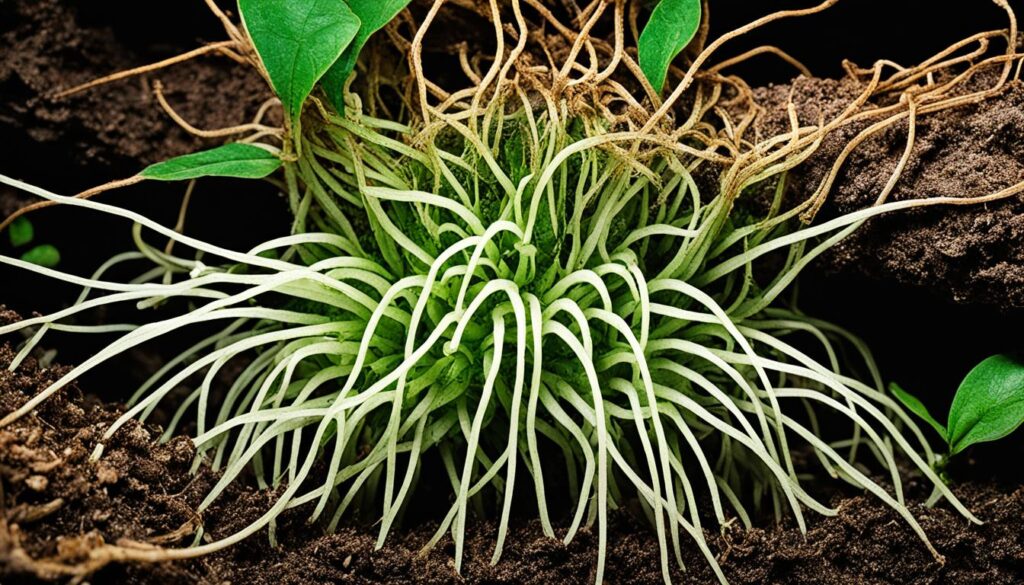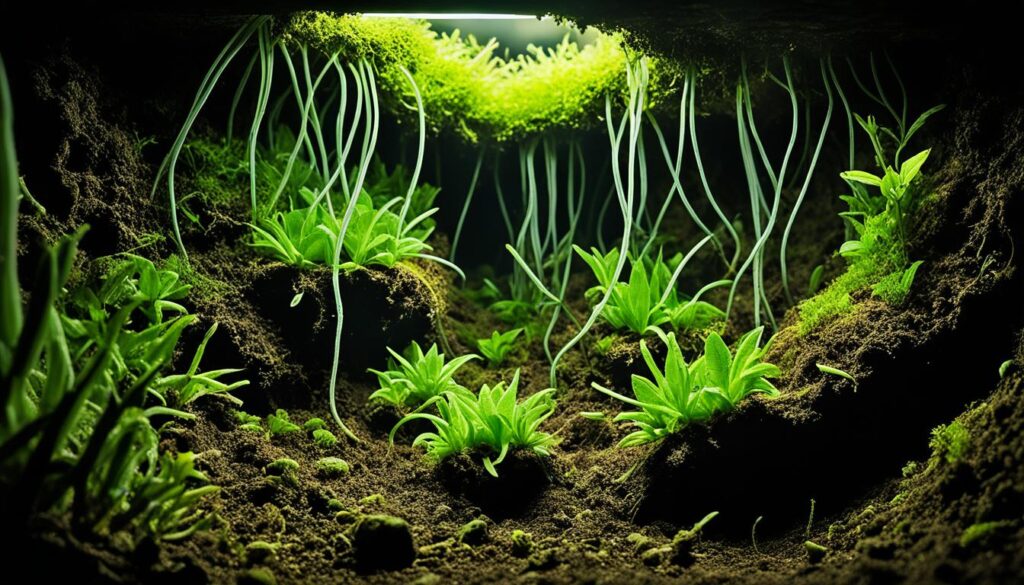
Have you heard of Genlisea, nature’s secret underdogs? These plants are carnivorous, known as «corkscrew plants». They have a unique way of catching their food. Genlisea traps are underground and catch tiny insects. This method shows how smart these plants are in surviving where there’s not much food available. What else could these plants teach us if we take a closer look? Let’s explore the amazing world of Genlisea and see what’s hidden right below our feet.
Uncovering the Marvels of Genlisea
Genlisea plants have interested botanists for centuries. They are known for their underground trap leaves. These are unique and show amazing evolutionary changes.
Charles Darwin first brought up the idea of Genlisea being carnivorous over 100 years ago. But, it wasn’t proven until 1998. This proof set off a lot of scientific interest in Genlisea, making it a top topic in botany.
The Genlisea genus is part of the group of carnivorous plants. There are more than 700 kinds globally. They have adapted in interesting ways to grow in places where there are few nutrients, showing us the power of life to adapt.
This journey tells a story of unusual plants, carnivorous habits, and changing over time. It’s a story that fascinates all who study plants.
| Key Insights on Carnivorous Plants | Highlights |
|---|---|
| Prevalence and Diversity |
|
| Ecological Adaptations |
|
| Conservation Concerns |
|
Scientific studies focus on Genlisea’s trap leaves for gathering nutrients. Its carnivorous trait was only fully shown in the late 1900s. This discovery keeps offering new information on how these plants adapt to survive with little nutrients.

Botanical Classification: Dissecting the Genus
The genus Genlisea is known for its subterranean trap plants. It showcases a great diversity in botanical classification. There are two main groups: Genlisea and Tayloria. Each has its own unique sections. These sections show the detailed organization of this plant group.
Subgenera and Sections
The subgenus Genlisea includes the following sections:
- Section Genlisea
- Section Tayloria
- Section Rophophytum
In contrast, the subgenus Tayloria has its own set of sections:
- Section Tayloria
- Section Globiflora
The Genlisea genus has a broad range of genome sizes. It shows that different species can have very varying amounts of DNA. The diversity in DNA content is vast, with up to 25 times as much DNA among different species. This highlights the wide range of botanical variety within this genus.
Global Distribution
Genlisea plants can be found all over the globe. They are naturally at home in Africa, Central America, and South America. Living in wetlands and semi-aquatic areas, these unique plants prove they can adapt to all kinds of environments.
This wide distribution shows how special the Genlisea genus really is. There is so much more to learn about this fascinating group of plants. Continuing to study them will surely reveal even more of their natural wealth.
| Species | Genome Size (Mbp) | Chromosome Count (2n) |
|---|---|---|
| Genlisea nigrocaulis | 86 | 40 |
| Genlisea hispidula | 1,550 | – |
| Genlisea aurea | 63.6 | 52 |
| Genlisea margaretae | 63.4 | 38 |

The diverse nature of the Genlisea genus, seen through its many subgenera, sections, and varying genome sizes, highlights the richness of its botanical world. There’s much to discover and explore in this fascinating plant group.
Genlisea: The Carnivorous Corkscrew Plants
Etymology and Genome Diversity
The name Genlisea comes from Stéphanie Félicité Ducrest de St-Albin. She was a French writer and educator. Known as the «carnivorous corkscrew plants,» they have a wide range of genetics.
Plants like G. margaretae, G. aurea, and G. tuberosa have very small genomes compared to other flowering plants. This shows how adaptable and tough these plants are. They really stand out as botanical curiosities.
Genlisea’s seeds are very small and need careful handling to grow. They love places with lots of moisture, such as wetlands. These plants can grow from seeds or by splitting them. This helps keep them around for study.
By studying their family tree and how certain features have changed over time, scientists have learned a lot. They’ve focused on the Genlisea plants’ chloroplasts. This has given us a peek into their genetic past and how they’ve evolved.
Scientists are also curious about the size of Genlisea’s genomes and chromosomes. This has sparked lots of research to better understand these plants. The more we learn, the more amazed we are by these botanical curiosities.
Dual-Leaf Design: Photosynthesis and Prey Capture
Genlisea plants stand out in the world of carnivorous plants. They use a special double-leaf structure for both making food through photosynthesis and catching prey. This design includes leaves above and below the ground for different tasks.
Aboveground Foliage Leaves
The part above ground does the photosynthesis work. These leaves are green and full of chlorophyll. They soak up the sunlight and turn it into food for the plant. This way, even in places with little food in the soil, Genlisea plants can still survive by eating captured prey.
Subterranean Trap Leaves
Underground, these plants have a unique feature – the trap leaves. They are white, soft, and have a ‘bulb’ at the bottom. This bulb part leads into a long, twisting tube. The trap leaves are perfect for catching and eating tiny animals like protozoa and rotifers. These organisms provide the plant with necessary nutrients that are scarce in the soil.
Genlisea’s special leaf setup shows their unique adaptations. They can survive in tough spots by combining the benefits of making their own food and catching prey. This incredible method keeps the plant healthy and strong.
Floral Allure: Attracting Pollinators
The Genlisea genus shows off its beauty with unique trap leaves and captivating flowers. These carnivorous plants grow several to many flowers on tall stems, displaying their tropical wonders> with pride.
Each Genlisea flower has a bilobed tube that comes to a point with a spur. It also has a lower lip with three lobes. The flowers can be bright yellow, soft violet, or creamy white, depending on the rare type. This mix of colors is nature’s way of inviting bees and flies to pollinate the plant.
The lower lip of the Genlisea flower has a platform for bees and flies. This platform sends smells and feels that attract and guide pollinators. The relationship between these plants and their visitors is a beautiful result of complex evolution.
Studying how Genlisea attracts pollinators helps us see the deeper connections in nature. This work helps us understand and protect both the plants and the environments they live in. It shows us the wonder and importance of botanical diversity.
Genlisea: A Genus of Evolutionary Wonders
The Genlisea genus is known as «corkscrew plants.» They have amazing adaptations to live in poor-nutrient places. These plants act as natural insecticides. They use their unique features to get nutrients from spots where resources are scarce. This makes them stand out as botanical curiosities.
Adaptations to Nutrient-Poor Environments
Many Genlisea plants are carnivorous. They catch and eat tiny creatures for food. This is key for them, as they live in places like bogs that lack nutrients.
Some, like G. tuberosa, can keep food and water in tubers. This helps them survive in places with little water or after a fire. During these tough times, they don’t have to worry about finding food or moisture.
- The carnivorous nature of Genlisea plants allows them to supplement their nutrient intake in nutrient-poor habitats.
- Some Genlisea species, such as G. tuberosa, have developed tubers to store carbohydrates and water, enabling them to survive in areas prone to fire or drought.
| Adaptation | Description | Benefit |
|---|---|---|
| Carnivorous Nature | Genlisea plants can trap and digest minute organisms to supplement their nutrient intake. | Allows them to thrive in nutrient-poor environments. |
| Tuber Development | Some Genlisea species, like G. tuberosa, have evolved the ability to store carbohydrates and water in tubers. | Enables survival in areas prone to fire or drought, where access to nutrients and moisture can be limited. |
These adaptations show how amazing the Genlisea plants are at surviving tough places. Studying these natural insecticides and botanical curiosities helps us learn about plant evolution. It’s cool to see how they’ve adapted to live in hard-to-reach places.
Taxonomic Treasures: Species Diversity
The genus Genlisea is known as the «corkscrew plants.» It is a rich source of 31 species, including the varied types of G. aurea. These are carnivorous plants.
Their differences show in the features of their flowers, such as the hair on them. For example, G. tuberosa grows tubers, and some have two types of traps. They might target different kinds of prey with these.
Plant lovers marvel at the diversity in the Genlisea genus. From the vibrant G. violacea to the dainty G. filiformis, each species is a rare find. They show the amazing changes nature can make through evolution.
This botanical diversity always interests scientists and people who love plants. Every new Genlisea plant we find adds to our understanding of life’s incredible variety. It is a story of adaptation and ingenuity.
Botanical Revelations: Early Discoveries
The Genlisea genus is known as a true marvel in the plant world. Its start was in 1833, when French botanist Augustin François César Prouvençal de Saint-Hilaire found and named four species. These were G. aurea, G. filiformis, G. pygmaea, and G. violacea. This discovery was key to understanding these intriguing carnivorous plants.
Charles Darwin hinted at their carnivory earlier, around the late 18th century. But it wasn’t until 1998 that the genus’s carnivorous nature was proved. This discovery marked a major breakthrough in understanding these unique plants.
The early findings of Genlisea revealed the diversity and special adaptations of these plants. They showed the world how unique and complex Genlisea plants are. From their underground traps to their detailed flowers, Genlisea plants continue to amaze scientists and plant lovers. They unveil new botanical secrets with every study.
| Year of Discovery | Species Discovered | Discoverer |
|---|---|---|
| 1833 | Genlisea aurea, G. filiformis, G. pygmaea, G. violacea | Augustin François César Prouvençal de Saint-Hilaire |
| Late 18th century | Concept of carnivory in Genlisea | Charles Darwin |
| 1998 | Conclusive proof of carnivorous nature in Genlisea | Extensive research |
These early discoveries shaped our understanding of the Genlisea plants. They have led to more research and exploration into these intriguing tropical plants. The Genlisea genus continues to surprise and fascinate us.
Genome Extremes: From Minuscule to Massive
The carnivorous corkscrew plants, Genlisea, stand out for their varied genome sizes. Their genome can be very small, like in G. nigrocaulis with only 86 Mbp. Meanwhile, G. hispidula, a close relative, has a genome 18 times larger at 1550 Mbp. This wide range shows the amazing diversity in Genlisea’s genetic makeup.
Species with small genomes are very rare, pointing to a link between genome size and species variety. On the other hand, more common and widespread species have larger genomes. This stark difference highlights the extreme genome variations in Genlisea. It also emphasizes the need to protect these plants from threats like environment changes.
Studying Genlisea’s varied genome sizes helps scientists learn about these unique plants’ adaptations and evolution. As we discover more about their DNA, your insight into Genlisea’s diversity and resilience grows. This makes you recognize and admire these incredible underground carnivorous plants even more.



